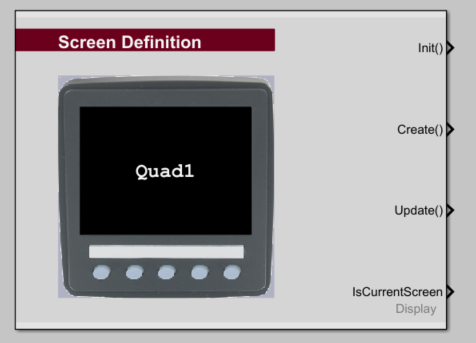Raptor:Display Screen Definition: Difference between revisions
Jump to navigation
Jump to search
No edit summary |
|||
| Line 7: | Line 7: | ||
== Description == | == Description == | ||
<p>This block is used to define a screen on the Veecan display. The output functions are called automatically when the screen is loaded or active.</p> | <p>This block is used to define a screen on the Veecan display. The output functions are called automatically when the screen is loaded or active.</p> | ||
== Outputs == | == Outputs == | ||
| Line 50: | Line 42: | ||
| String | | String | ||
| Name of screen being defined. | | Name of screen being defined. | ||
|- | |||
! Select at Initialization | |||
| edit | |||
| Selects whether this screen is displayed at startup. | |||
|- | |||
! Use Simulink Functions | |||
| checkbox | |||
| Whether to use Simulink Function callbacks instead of function-call ports. | |||
|- | |||
! Use Init Screen Simulink Function | |||
| String | |||
| Name of the Simulink Function to call when this block's Init function is triggered. | |||
|- | |||
! Use Create Screen Simulink Function | |||
| checkbox | |||
| Selects whether to use a Create Screen Simulink Function callback. | |||
|- | |||
! Create Screen Simulink Function Name | |||
| String | |||
| Name of the Simulink Function to call when this block's Create function is triggered. | |||
|- | |||
! Use Update Screen Simulink Function | |||
| checkbox | |||
| Selects whether to use an Update Screen Simulink Function callback. | |||
|- | |||
! Update Screen Simulink Function Name | |||
| String | |||
| Name of the Simulink Function to call when this block's Update function is triggered. | |||
|- | |||
! Create (with Init, Create, and Update Screen Functions) | |||
| buttons | |||
| Create a Simulink Function to use with the Screen Definition block. | |||
Must first provide a valid function name. | |||
|- | |||
! Update(with Init, Create, and Update Screen Functions) | |||
| buttons | |||
| Update the listed Simulink Function's signature to 0 inputs & 0 outputs. | |||
The Simulink Function listed in the box must already exist. | |||
|} | |} | ||
Latest revision as of 16:00, 13 September 2023
Return to the main Raptor page
Return to Screen Functions page

Description
This block is used to define a screen on the Veecan display. The output functions are called automatically when the screen is loaded or active.
Outputs
| Output | Type | Description |
|---|---|---|
| Init() | FnCall | This function is called once when the screen is entered. |
| Create_Background() | FnCall | This function is called when the screen is entered or if the screen was invalidated. It should draw the static elements of the screen. |
| Update_Foreground() | FnCall | This function is called regularly when the screen is active to update the dynamic elements of the screen. |
| IsCurrentScreen | boolean | Output indicates if this screen is the current screen. |
Parameters
| Parameter | Type | Description |
|---|---|---|
| Screen Name | String | Name of screen being defined. |
| Select at Initialization | edit | Selects whether this screen is displayed at startup. |
| Use Simulink Functions | checkbox | Whether to use Simulink Function callbacks instead of function-call ports. |
| Use Init Screen Simulink Function | String | Name of the Simulink Function to call when this block's Init function is triggered. |
| Use Create Screen Simulink Function | checkbox | Selects whether to use a Create Screen Simulink Function callback. |
| Create Screen Simulink Function Name | String | Name of the Simulink Function to call when this block's Create function is triggered. |
| Use Update Screen Simulink Function | checkbox | Selects whether to use an Update Screen Simulink Function callback. |
| Update Screen Simulink Function Name | String | Name of the Simulink Function to call when this block's Update function is triggered. |
| Create (with Init, Create, and Update Screen Functions) | buttons | Create a Simulink Function to use with the Screen Definition block.
Must first provide a valid function name. |
| Update(with Init, Create, and Update Screen Functions) | buttons | Update the listed Simulink Function's signature to 0 inputs & 0 outputs.
The Simulink Function listed in the box must already exist. |